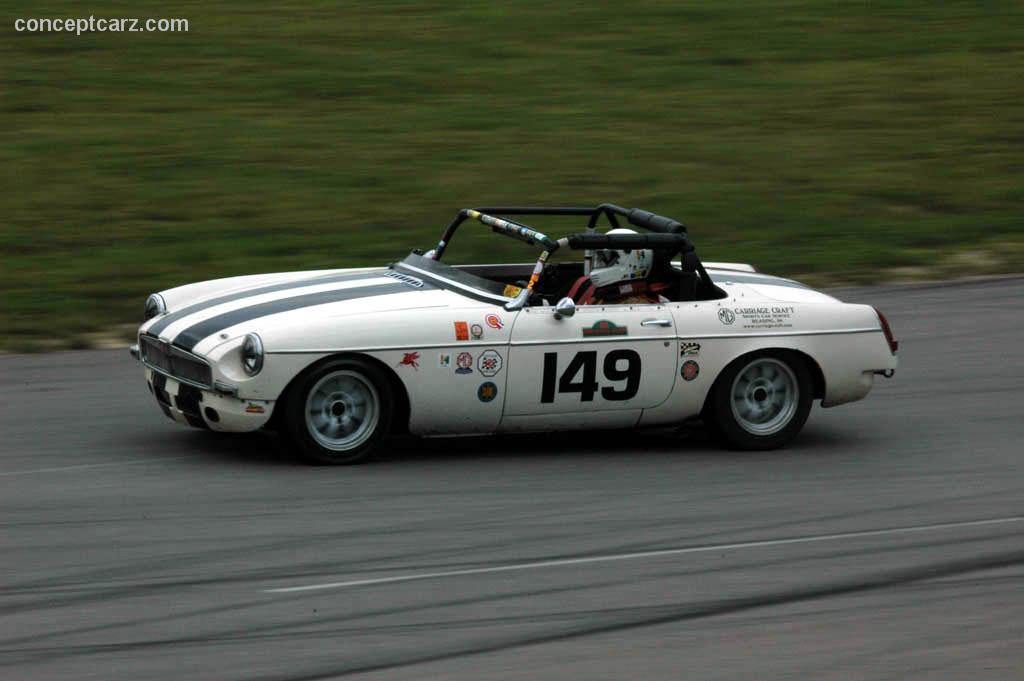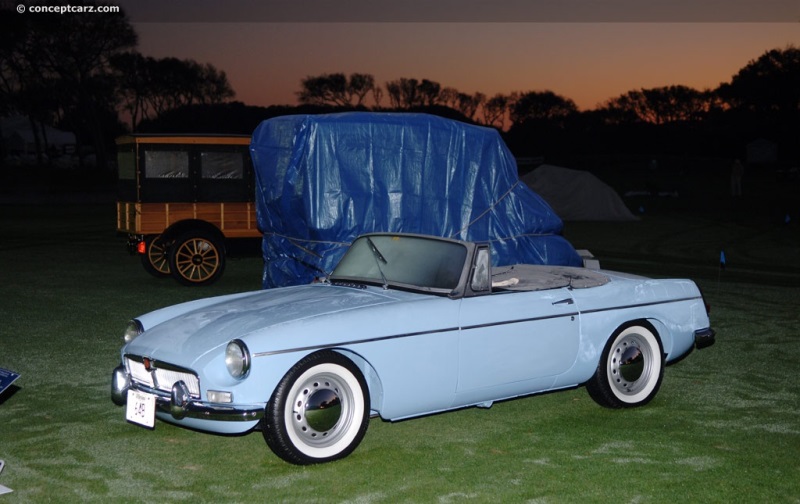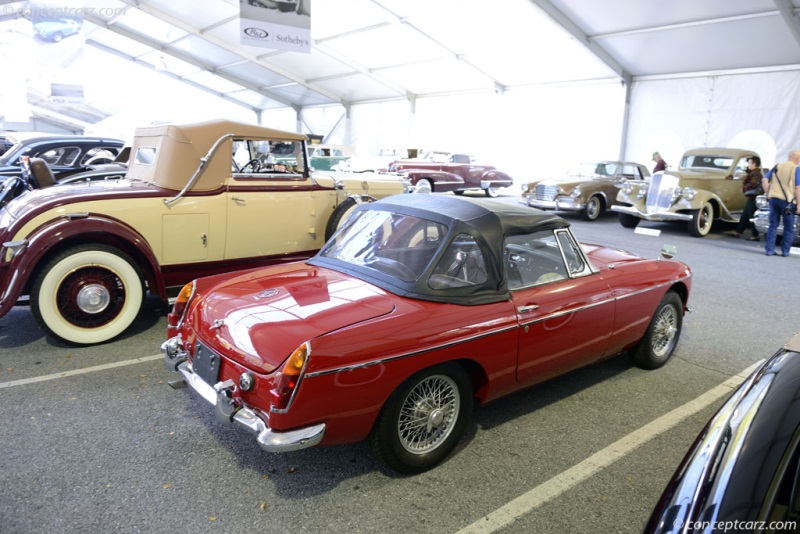The MGB replaced the outgoing MGA in May 1962 and would remain in production until the Abingdon factory finally closed in 1980. Differences between the 'A' and the 'B' centered on comfort, with more legroom and more creature comforts including wind-up windows. The suspension was slightly softer than the MGA, shedding some of its sporty characteristics in the pursuit of comfort, and initially, the body style was solely a roadster. Variants that arrived later in production included the three-door 2+2 MGB GT coupe of 1965 through 1980, the six-cylinder sports car and coupe MGC (built from 1967 through 1969) and the eight-cylinder MGB GT V8 2+2 coupe of 1973 through 1976. By the time production came to a close in 1980, a total of 523,836 combined MGB (including the MGC and MGB GT V8) vehicles were built.
RoadsterSpecifications
The prototype, known by its codename - MG EX205, was built in the late 1950s (as early as 1958), testing designs and construction that would eventually become the MGB. While the MGA and MG T-Types had used traditional body-on-frame construction, the MGB received a unitary structure and was one of the earliest cars to receive controlled crumple zones designed to protect the driver and passenger in a 30 mph impact with an immovable barrier. The suspension and brakes were developments of the previous Lockheed hydraulic drums and an independent suspension setup used on the MGA. The 'A' had used coil springs and wishbones at the front while the rear utilized a rigid axle with semi-elliptic springs. The 'B' continued to use an independent front setup with a live rear axle. In the front were 11-inch solid disc brakes with drums at the rear. Lockheed manufactured the front brake calipers and used two pistons per cylinder. The 'banjo' type differential used on the MGA continued to be used on the early MGBs but with the 4.1 rear axle ratio reduced to 3.9 to 1. A tube-type axle arrived in 1968, corresponding with the arrival of the MGB GT, and was better designed to cope with the increase in power. The brakes of the GT had slightly larger rear brake cylinders but others were the same as the roadster. Dual-circuit brakes replaced the single-circuit hydraulic system in 1968. Servo-assisted brakes became standard in 1975. Beneath the bonnet was a three-bearing 1,798cc B-series engine with a SU-built electric fuel pump, gaining a positive crank-case breathing in February of 1964 and a five-bearing crankshaft in October of that year. Both the three and five-main bearing cars developed 95 (net) horsepower and 105 lb/ft of torque at 2,500 RPM. The MGA had a displacement size of 1,622 while the MGB measured 1,798cc. MGB models destined for export (from 1975 onwards) were given de-tuned (compression ratio decreasing from 9:1 to 8:1) engines to comply with strict emission, rubber bumpers designed to meet bumper standards were added to the front and rear, and the ride height decreased by an inch. The compression ratio in these engines decreased from 9:1 to 8:1 and the twin 1.5-inch SU carburetors were replaced with a single Stomberg 1.75-inch unit mounted on a combination intake/exhaust manifold. MGB vehicles built from 1962 to 1967 received a four-speed manual gearbox with a non-synchromesh, straight-cut first gear. An overdrive system was offered as optional equipment. A full synchromesh unit based on the MGC gearbox arrived in 1968 and better suited to cope with the three-liter engine of the MGC and the 3.5-liter V8 of the MGB GT V8. The MGB
The MGB was three inches shorter than the MGA but it offered more passenger space and more room for luggage. Its suspension was smoother but its larger engine compensated for any loss of performance. The wheel diameter decreased from 15 to 14 inches.A Mark II version was introduced in 1968, corresponding to the changes made to the transmission, new gear ratios, a new rear axle, an alternator in place of the dynamo with a change to a negative earth system, and the optional Borg-Warner 35 automatic gearbox (not including the U.S. market). The new gearboxes required significant changes to the sheet metal in the floorpan, along with a new flat-topped transmission tunnel. MGBs exported to the U.S. received dual circuit brakes and a plastic and foam rubber-covered 'safety' dashboard (other markets continued to use steel dashboards). Numerous minor changes were made to the MGB in response to U.S. regulations, including three windscreen wipers (up from two) for 1969, side marker lamps, and high seat backs with head restraints. The following year, the new front grille was recessed and built from black aluminum. In 1973, the polished grille returned, albeit with a 'honeycomb' insert. The 1970 models had a split rear bumper with room for the number-plate in between, while the 1971 through 1974 examples used the earlier single-piece full-length style chrome bumper. The chrome bumper over-riders were placed in 1974 with oversized rubber ones. Later in 1974, the chrome bumpers were replaced by a new, steel-reinforced black rubber bumper at the front incorporated into the grille area. A similar bumper was used at the rear.Conclusion
The MGB enjoyed a lengthy eighteen-year production run with over half a million examples sold. They were the most popular sports car ever made in Britain, thanks in part to their affordability, practicality, and attractive and thoroughly enjoyable two-seater roadster body. They were the final and most successful sports car to wear the Octagon badge. The 1.8-liter engine offered plenty of punch and its well-sorted suspension offered predictable handling.
by Daniel Vaughan | Jan 2022

Roadster
The prototype, known by its codename - MG EX205, was built in the late 1950s (as early as 1958), testing designs and construction that would eventually become the MGB. While the MGA and MG T-Types had used traditional body-on-frame construction, the MGB received a unitary structure and was one of the earliest cars to receive controlled crumple zones designed to protect the driver and passenger in a 30 mph impact with an immovable barrier. The suspension and brakes were developments of the previous Lockheed hydraulic drums and an independent suspension setup used on the MGA. The 'A' had used coil springs and wishbones at the front while the rear utilized a rigid axle with semi-elliptic springs. The 'B' continued to use an independent front setup with a live rear axle. In the front were 11-inch solid disc brakes with drums at the rear. Lockheed manufactured the front brake calipers and used two pistons per cylinder. The 'banjo' type differential used on the MGA continued to be used on the early MGBs but with the 4.1 rear axle ratio reduced to 3.9 to 1. A tube-type axle arrived in 1968, corresponding with the arrival of the MGB GT, and was better designed to cope with the increase in power. The brakes of the GT had slightly larger rear brake cylinders but others were the same as the roadster. Dual-circuit brakes replaced the single-circuit hydraulic system in 1968. Servo-assisted brakes became standard in 1975. Beneath the bonnet was a three-bearing 1,798cc B-series engine with a SU-built electric fuel pump, gaining a positive crank-case breathing in February of 1964 and a five-bearing crankshaft in October of that year. Both the three and five-main bearing cars developed 95 (net) horsepower and 105 lb/ft of torque at 2,500 RPM. The MGA had a displacement size of 1,622 while the MGB measured 1,798cc. MGB models destined for export (from 1975 onwards) were given de-tuned (compression ratio decreasing from 9:1 to 8:1) engines to comply with strict emission, rubber bumpers designed to meet bumper standards were added to the front and rear, and the ride height decreased by an inch. The compression ratio in these engines decreased from 9:1 to 8:1 and the twin 1.5-inch SU carburetors were replaced with a single Stomberg 1.75-inch unit mounted on a combination intake/exhaust manifold. MGB vehicles built from 1962 to 1967 received a four-speed manual gearbox with a non-synchromesh, straight-cut first gear. An overdrive system was offered as optional equipment. A full synchromesh unit based on the MGC gearbox arrived in 1968 and better suited to cope with the three-liter engine of the MGC and the 3.5-liter V8 of the MGB GT V8. The MGB
The MGB was three inches shorter than the MGA but it offered more passenger space and more room for luggage. Its suspension was smoother but its larger engine compensated for any loss of performance. The wheel diameter decreased from 15 to 14 inches.A Mark II version was introduced in 1968, corresponding to the changes made to the transmission, new gear ratios, a new rear axle, an alternator in place of the dynamo with a change to a negative earth system, and the optional Borg-Warner 35 automatic gearbox (not including the U.S. market). The new gearboxes required significant changes to the sheet metal in the floorpan, along with a new flat-topped transmission tunnel. MGBs exported to the U.S. received dual circuit brakes and a plastic and foam rubber-covered 'safety' dashboard (other markets continued to use steel dashboards). Numerous minor changes were made to the MGB in response to U.S. regulations, including three windscreen wipers (up from two) for 1969, side marker lamps, and high seat backs with head restraints. The following year, the new front grille was recessed and built from black aluminum. In 1973, the polished grille returned, albeit with a 'honeycomb' insert. The 1970 models had a split rear bumper with room for the number-plate in between, while the 1971 through 1974 examples used the earlier single-piece full-length style chrome bumper. The chrome bumper over-riders were placed in 1974 with oversized rubber ones. Later in 1974, the chrome bumpers were replaced by a new, steel-reinforced black rubber bumper at the front incorporated into the grille area. A similar bumper was used at the rear.Conclusion
The MGB enjoyed a lengthy eighteen-year production run with over half a million examples sold. They were the most popular sports car ever made in Britain, thanks in part to their affordability, practicality, and attractive and thoroughly enjoyable two-seater roadster body. They were the final and most successful sports car to wear the Octagon badge. The 1.8-liter engine offered plenty of punch and its well-sorted suspension offered predictable handling.
by Daniel Vaughan | Jan 2022
Related Reading : MG MGB History
By the end of the 1950s, the MGA was starting to feel its age and a replacement car was needed. The replacement was expected to focus on performance and comfort. The MGB introduced improvements over the prior MG model that including roll-up windows and glove compartments, to name a few. In 1957, Frua, an Italian stylist, was commissioned to style a new car. What was original conceived as a closed....
Continue Reading >>
Continue Reading >>
Similar Automakers
Similarly Sized Vehicles
from 1964
Similarly Priced Vehicles
Mercury Comet ($2,125-$2,660)
Ford Galaxie 500 ($2,611-$3,485)
Morgan 4/4 Series V ($2,660-$2,660)
Chevrolet Chevelle Series ($2,235-$2,860)
Studebaker Daytona ($2,310-$2,840)
Ford Falcon ($1,985-$2,660)
Oldsmobile F-85 ($2,330-$3,485)
AMC Rambler Classic ($2,065-$2,755)
Dodge 330 Series ($2,265-$2,755)
Buick Skylark ($2,670-$2,835)
Average Auction Sale: $18,729
Ford Galaxie 500 ($2,611-$3,485)
Morgan 4/4 Series V ($2,660-$2,660)
Chevrolet Chevelle Series ($2,235-$2,860)
Studebaker Daytona ($2,310-$2,840)
Ford Falcon ($1,985-$2,660)
Oldsmobile F-85 ($2,330-$3,485)
AMC Rambler Classic ($2,065-$2,755)
Dodge 330 Series ($2,265-$2,755)
Buick Skylark ($2,670-$2,835)
Average Auction Sale: $18,729
1964 MG B Vehicle Profiles
Recent Vehicle Additions
Performance and Specification Comparison
Price Comparison
$1,950
MGB MKI Specification Comparison by Year
Year
Production
Wheelbase
Engine
Prices
Related Automotive News

Volkswagen Type 4
Herndon, VA — In 1968, the iconic Beetle had been selling by the millions every year, establishing Volkswagen as one of the worlds largest exporter of automobiles. Still, continued success demanded an ever-evolving portfolio, with evolutionary...

The Ultimate Beach Cruiser: The 1974 Volkswagen Acapulco Thing
The Volkswagen Type 181 – commonly referred to as The Thing – has always been a fun summer classic for drivers who enjoy a cool and wildly original type of ride. The removable doors, retractable soft top and folding windshield provided a driving experience...

London Concours 2020 To Celebrate 'Lost Marques'
The London Concours has announced the Lost Marques display – an homage to those marques we have loved and lost
Models from the likes of Facel Vega, Bizzarrini, Austin Healey, Alvis, Jensen and many more will grace the lawn as part of the display...

THREE TIMES FOUR: RM SOTHEBY'S BRINGS ASTON MARTIN TRINITY TO LONDON SALE WITH DB4GT, DB4 CONVERTIBLE AND DB4 SERIES II COUPÉ
RM Sothebys assembles holy trifecta of DB4s for its 10th anniversary London sale, 7 September at Battersea Evolution
Trio led by original one-of-75 DB4GT, immaculate concours-standard Series V Convertible, and desirable left-hand-drive Series...

Extremely Original 'Holy Grail' 1970 Oldsmobile 442 W-30 Convertible at Russo and Steele's 2016 Arizona Auction Event
Scottsdale, Arizona (November 24, 2015) – While Oldsmobile is believed to have created the first true American muscle car with the release of its 303 V-8 Rocket 88 in 1949, it was not until 1964 that it returned to the concept with the 442 option,...

























